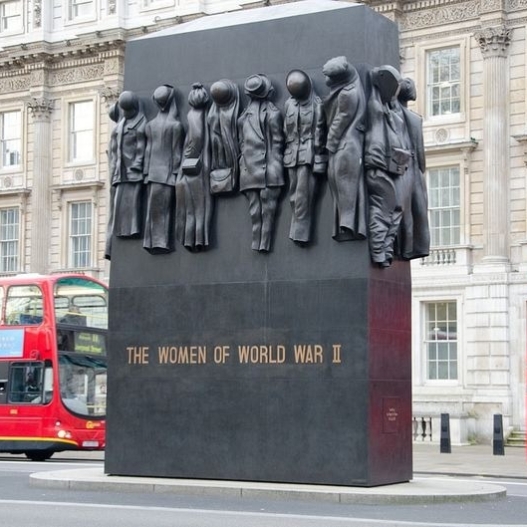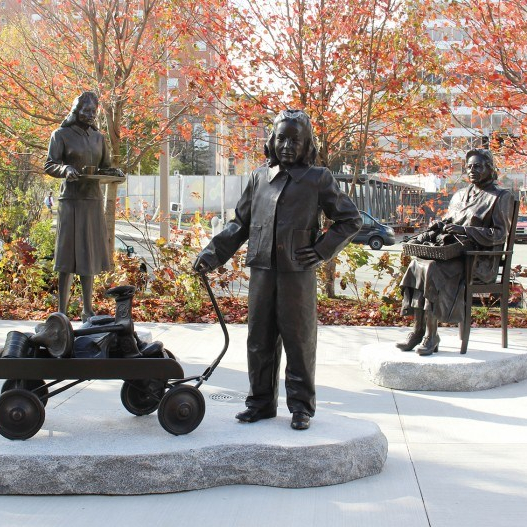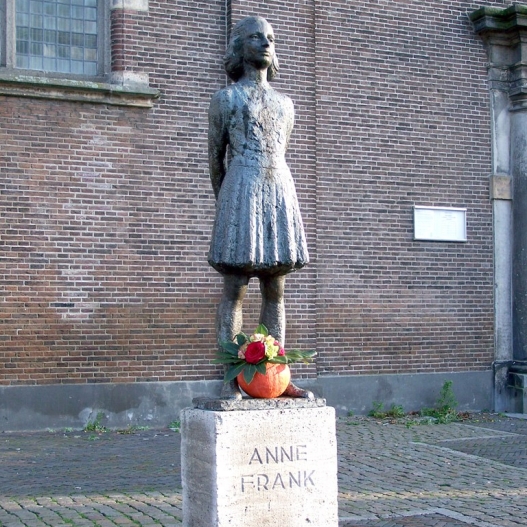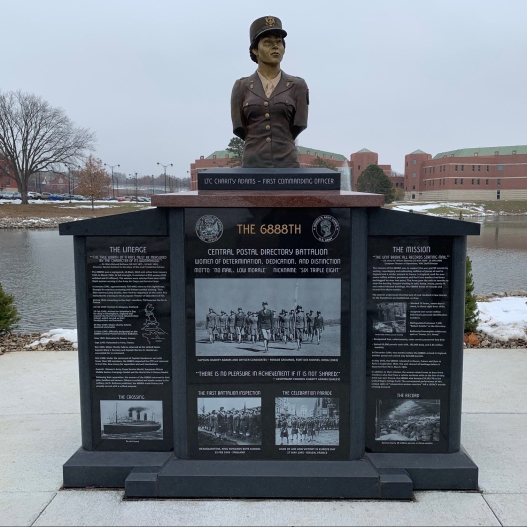We need to talk about statues. No matter where you live, there’s likely to be a couple of them in prominent places, enshrining important events, celebrating local legends or praising notable individuals. Statues and sculptures are often the defining features of a place, a visual manifestation of a country’s beliefs and history. Nothing is more symbolic or emotional than seeing a statue being erected or pulled down, either signifying a person’s importance or the end of their influence.
Now, think again. How many of those statues are of women? Real women, not the naked ladies we often encounter bearing torches, weeping, or flinging garlands in their roles as symbols of peace, motherhood, victory and other abstract concepts. You can probably count them on one hand. It will hardly come as a surprise that around the world, statues of real men outnumber those of real women. Their absence in our streets, squares and parks suggests that they were never there to begin with, or rather, that their contributions to the fabric of a city or country are too insignificant to be remembered. Therefore, it often seems as if the women of a city or country have no past, unless they participated in a major event like a protest or an uprising, in which case their suffering is often turned into a generic symbol.
I was therefore surprised when in May of last year, while walking down Canal Street in New Orleans, I noticed the statue of a woman – a life-size, purposeful-looking woman, fully dressed in what I instantly recognized as a WWII armed services uniform. The plaque said it was ‘Molly Marine’, created in 1943 to honour “women marines who serve their country in keeping with the highest traditions of the United States”. Given that New Orleans was an important city during the war, both because of its shipbuilding industry (including the famous Higgins boats used during the D-Day invasion) and the entertainment it offered to the troops in training camps nearby, the statue’s location is not that surprising.
After writing about WWII memorials that were designed by women, I started thinking about statues of women during WWII. In my previous post I mentioned a few of them, including the Rosie the Riveter memorial. Here are ten other notable ones I found.
1 Molly Marine – New Orleans, USA
As I said above, the Molly Marine statue represents a group of women, but she was made in the likeness of a real woman: former Marine and New Orleans native Judy Mosgrove. In 1943, a Marine sergeant decided to erect a statue that would encourage women to join the Marine Corps. He asked a New Orleanian to design it, Enrique Alferez, who due to rationing had to make do with granite and marble chips rather than bronze. I couldn’t find any data about whether Molly actually caused an influx of women in the USMC, but the fact that Molly Marine Awards are still given yearly to women Marines for noteworthy achievements probably makes the case for her contribution. Major General Angela Salinas, the first Latina woman to become a general in the USMC, said: “She stands as a constant reminder of my roots and the legacy that’s been entrusted to me,” adding that the statuette gave her the confidence to reach beyond what she would have imagined herself doing.

2 Monument to the Women of World War II – London, UK
Arguably the most famous statue dedicated to women’s service during WWII, this monument, which was erected in 2005, sits in the middle of Parliament Square, close to the Cenotaph commemorating all British war dead since WWI. Sculpted on the sides of the big, black bronze block are 17 different outfits that symbolize the hundreds of different wartime jobs taken on by British women, including Land Army and Women’s Royal Naval Service (WREN) uniforms, a nursing cape, a police overall and a welding mask.
Many of these jobs were filled by women after the men went to war, and in many cases they had to give them up again after the war ended. For many women who for the first time in their lives had meaningful work and their own income, going ‘back into the box’ in 1945 was a slap in the face. Controversially, the monument seems to enshrine the temporary nature of women’s war work by depicting the clothes they wore hung on a peg after having to give up their job. Moreover, for a statue that is dedicated to the millions of women who served their country, it’s rather conspicuous that there are no actual female figures on it. By contrast, many war memorials do feature male figures, even anonymous ones, so their presence is still asserted. This memorial seems to underline the idea that women had no real presence in the conflict because they didn’t fight, even if they did pretty much every other job imaginable (and bore the brunt of the fighting as ‘collateral damage’). This is a good example of how statues are used to erase parts of history; it perpetuates the idea that it’s okay for women to just not be there and go unacknowledged for what they have contributed.

3 Australian Servicewomen’s Memorial – Sydney, Australia
If only there was a way to honour women’s contributions to the war without erasing their faces! The Australian Servicewomen’s Memorial in Sydney sets a better example. Dedicated to the wartime women of New South Wales, the memorial consists of a bronze statue of a uniformed servicewoman standing on a sandstone plinth in front of a sandstone wall. To her right is a bronze bas-relief illustrating the fields in which women served in WWII, including medical services, the army, the navy, and the air force. The statue was erected by the Council of Ex-Servicewomen’s Association and designed by Sydney artist Dennis Adams.

4 Monument to the Partisan Woman – Venice, Italy
On the waterfront in Venice, a city famous for its constant battle with rising sea levels, there is a well-disguised monument to the city’s female partisans during WWII. After his monument Venice, to her Partisan Women was vandalized in 1955, Venetian architect Carlo Scarpa created a new monument. A 1200kg bronze sculpture of a reclining woman, designed by Augusto Durer, rests on a floating platform, designed to move with the rising and falling tide so that she seems to be resting on the water surface. At high tide, she is partly or fully submerged. She’s surrounded by square stepping stones that lead the visitor down towards the sculpture. The monument is situated at the entrance of the Via Garibaldi on the Riva dei Sette Mattri (Riverbank of the Seven Martyrs), a highly symbolic place. Here, in 1941, seven Italian men were executed by a German firing squad in reprisal for the death of a German sentry, who, it later turned out, had simply fallen into the water and drowned.
Can we read any symbolic value into the constant disappearance and reappearance of the woman, as with the London monument? The monument is “dedicated to those women of the Resistance who but for this work would have contributed silently to the regaining of liberty by Italy” – meaning, of course, not silently at the time, but silenced later by erasure from the historical record. Given Scarpa’s desire to have the monument interact with its surroundings and especially the water, I think it may well be symbolic; maybe he wanted to emphasise how time erodes our collective memory of what happened during the war, as the water erodes the bronze statue.

5 Comfort women statues (Manila, Seoul, Tainan, San Francisco and other cities)
Few war memorials have stirred up more controversy and emotions than the statues of ‘comfort women’ that have appeared around the world over the past decade. More than any other statues, they symbolize the bravery and determination of women to gain a foothold in the annals of history and make sure their story isn’t forgotten.
During WWII, the Imperial Japanese Army recruited young women from occupied countries as ‘comfort women’ for their soldiers – a euphemism for sexual slavery. Estimates about the number of women affected range from 20,000 to 400,000; the exact numbers are uncertain. Lured with promises of work or higher education, these women (mainly Korean, Chinese and Filipina, but also from Taiwan, the Dutch East Indies and Australia) were sent to ‘comfort stations’ across Southeast Asia. This way, the IJA reasoned, Japanese soldiers wouldn’t rape local women, thereby keeping the peace in the occupied territories and keeping medical costs for venereal diseases to a minimum. Thoughtful, isn’t it?
As the number of surviving comfort women quickly dwindles, requests for a public apology from Japan are increasing. The danger of erasure is very real, as shown by the passionate response from Japanese officials to the statues, who consider them thorns in their sides. The first one was erected in 2011 in Seoul, South Korea, in front of the Japanese embassy. At this time there are more than 50, including a painted sculpture of a young girl, aged about 13, on a bus which stops in front of the embassy. She is visible every time the bus doors open. Japan has paid compensation money to Korea and other countries “for psychological wounds”, but this, activists claim, is not enough. South Korea has even instituted a special holiday on August 14, Memorial Day for Japanese Forces’ Comfort Women Victims. It was on this day in 1991 that former comfort woman Kim Hak-sun became the first to give a public testimony about her experience.
Other countries have followed. A comfort woman statue on the Roxas Boulevard in Manila in the Philippines, installed as recently as December 2017, lasted a whole four months before being removed. Created by Filipino artist Jonas Roces, the statue of the blindfolded woman, standing tall with her hands pressed to her breast and facing the direction of Japan, was removed in April of 2018 after causing a storm of controversy. The Department of Public Works and Highways allegedly removed it for a flood control project, but did so in the middle of the night – not suspicious at all. President Duterte later stated that the statue was removed to avoid complicating relations with Japan.
Other notable locations are Tainan, in Taiwan, and San Francisco. In both cases, the raising of the statue was followed by political rumblings. The Taiwan memorial of a girl with her hands raised in resistance, unveiled in 2018, is the first public memorial to comfort women in the country. Though it was erected by a non-profit group called the Tainan Association for Comfort Women’s Rights, not the government, the Taiwanese president attended the ceremony and called for a public apology from Japan. The San Francisco statue, raised in 2017, depicts three girls – one Chinese, one Korean and one Filipina – holding hands, on top of a pedestal. On the ground below them stands a grandmother, representing the now-aged victims hoping for justice. Predictably, the statue evoked a response from the city’s large Japanese community, saying it was an example of Japan being singled out for war atrocities that had been committed by other nations as well. To my knowledge, however, this extensive brothel system – based on the geisha system at the Japanese court – was pretty unique for Japan. Osaka threatened to cut ties with San Francisco, its sister city, claiming that these statues provide a one-sided view of history “without presenting credible evidence”.




6 The Volunteers – Halifax, Canada
In 2017, a monument was raised on the waterfront in the Canadian city of Halifax to commemorate the duties performed by women on the home front for the Canadian troops stationed there during the war. They worked in canteens serving them dinner and sandwiches, knitted scarves, collected scrap metal or entertained them on the piano in the evening. The sculpture, made by artist Marlene Hilton Moore, includes three figures: a young girl pulling a wagon full of salvage metal materials, an African-Nova Scotian woman working in one of the many canteens that fed servicemen around the city, and an older woman sitting in a chair knitting with a Mi’kmaq basket. The statue was initiated by the Halifax Women’s History Society.

7 Anne Frank statue – Utrecht, the Netherlands
One of the memorials closest to me personally is the statue of Anne Frank in the centre of Utrecht. Anne didn’t have a special connection to Utrecht – there are two more statues of her in Amsterdam – but it was a gift from several youth organisations to the municipality, who admired her spirit. Anne Frank has become a symbol of the Holocaust in the Netherlands; though she herself was a German refugee, we have appropriated her as an icon of Dutch resistance to the German occupiers. The statue was unveiled in 1959, the year in which Anne would have turned 30, and was made by Pieter d’Hont. The statue is nearly always surrounded by flowers, put there by several parties as a kind of ritual. This includes the members of a sorority, who leave Anne flowers when they graduate, as a tribute to a girl just like them who had dreams and plans, but didn’t live to act on them.

8 The 6888th Monument – Fort Leavenworth, Kansas, USA
Few things cheered up a soldier in a muddy foxhole more than letters from home. In 1944, to avoid a dip in the morale of American servicemen owing to millions of undelivered packages and letters sitting in an air hangar in Birmingham, England, the 6888th Central Postal Delivery Battalion was formed. It was the first and only all-female African-American battalion to be deployed overseas during the war, consisting of 824 enlisted women and thirty-one officers and led by Maj. Charity Edna Adams Earley, the first African American woman to achieve the rank of lieutenant colonel in the U.S. Army. Enduring the cold, blackout, buzz bombs, rats and countless letters simply addressed to ‘Robert Smith’, the women nevertheless did a six-month job in three, working seven days a week and sorting out nearly 65,000 pieces of mail a day. From Birmingham the battalion was redeployed twice, to Rouen and Paris, and then flown home to Fort Dix in New Jersey in 1946, where they were greeted without ceremony or public recognition. On November 30, 2018, a monument was dedicated to them at Fort Leavenworth in Kansas, and the ceremony was attended by five surviving members of the battalion. The monument shows a 25-inch bronze bust of Lt. Col. Earley and bears the names of five hundred battalion members.

9 Block of Women – Berlin, Germany
In 1943, hundreds of German women poured into a square in the Rosenstrasse in Berlin for a week-long mass protest against the Nazi government – a rare occasion where resistance was actually effective. Up until this point, Jews married to gentiles had been excluded from deportations; now, however, the Nazis began arresting them by the hundreds. Around 2,000 Jewish men were interned in the administrative building of the Jewish community on the Rosenstrasse, and their spouses came from all over the city to protest against their internment. Undeterred by verbal threats and machine guns trained on them, the women stayed there, secure in their numbers; eventually, Goebbels, who was apparently impressed by the women’s decision to risk their lives for their husbands and sons, ordered the release of the men, most of whom lived through the war.
A sculpture group called “Block der Frauen” (Block of Women) stands on the Rosenstrasse today, not far from that building. Carved in the 1980s by the German sculptor and communist Ingeborg Hunzinger, the monument was erected in 1995, after the fall of the GDR. The red stone blocks almost have something of a classical frieze about them, depicting the collective but also the personal grief of the women, among plenty of carved Jewish symbols and an inscription which reads: “The strength of civil disobedience, the vigor of love overcomes the violence of dictatorship; give us our men back; women were standing here, defeating death; Jewish men were free.”

10 Women of Ravensbrück memorial – Ravensbrück, Germany
Ravensbrück was the only Nazi concentration camp exclusively for women. Located close to Berlin, it saw some 130,000 women from 20 different nationalities pass through, who were deemed social outcasts, gypsies, political dissenters, foreign resisters, disabled or otherwise ‘inferior’. Though around 30,000 to 50,000 people were killed there, Ravensbrück was not an extermination camp – only about 10 per cent of its inmates were Jews. It provided slave labour to some of the thousands of sub-camps that made up the Nazi war machine, including the Siemens plant. The Nazis also experimented on Polish women, some of whom had their legs cut open and infected with bacteria and glass shards to simulate the effect of shrapnel.
A sculpture by Will Lammert, Tragende (Woman with Burden), placed there in 1959, overlooks the Schwedtsee next to the former KL. One emaciated woman carries another. The original design had more women surrounding the base of the column, but Lammert died in 1957, before his sculpture was finished. In 1985, his family had some of these leftover statues cast in bronze and placed on the Große Hamburger Straße, where they serve as a more general reminder of the deportations there. Lammert did design another statue for Ravensbrück: Frauengruppe.


We can draw some interesting conclusions from this list. All statues have a highly symbolic function: they celebrate or commemorate. In some cases, like that of the comfort women, it is symbolic of the struggle between citizens and government to bring untold stories, especially traumatic stories, to the public eye. The lack of female figures on the London monument, too, is painful evidence that the contributions of these women have gone publicly unacknowledged up to this point.
What I found noticeable was the lack of real, named women, apart from Anne Frank and Lt. Col. Earley on the 6888th Memorial. It is certainly understandable that in the time of a war that upended the lives of so many people in so many countries and reduced many of them to numbers (a time, too, where society was much less individualistic than it is now), the suffering and courage of individuals is commemorated through symbolic statues. What’s noticeable though is that many of the statues are quite recent and date from the last 5 years. This points to a final effort of those who are still alive to get their contributions recognised. For some it seems ‘too little, too late’, but we must bear in mind the efforts made by women to get most of these statues erected. Many of these statues received no or little support from the government, suggesting that women’s history is by many people still not considered part of ‘our history’.



One thought on “Re:member: Women and WWII memorials”